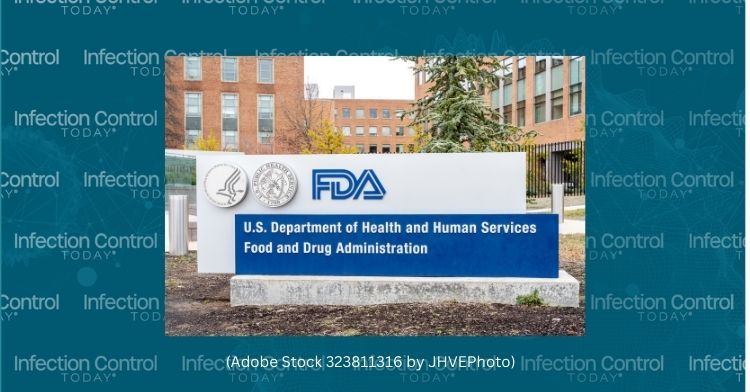GSK's 5-in-1 Meningococcal Vaccine Candidate BLA Accepted by FDA: A Potential Game-Changer in IMD Prevention
The FDA has accepted GSK's BLA for a 5-in-1 meningococcal vaccine candidate, which promises streamlined immunization and a potential reduction in invasive meningococcal disease (IMD).
The FDA sign.
(Adobe Stock 323811316 by JHVEPhoto)

GSK announced on April 16, 2024, a significant milestone has been achieved in the development of a meningococcal vaccine candidate, as the FDA has accepted the Biologics License Application (BLA). The vaccine, called the 5-in-1 meningococcal ABCWY (MenABCWY) vaccine candidate, is a promising advancement in preventing invasive meningococcal disease (IMD). A regulatory decision is expected by February 14, 2025, which marks an important step towards potential approval.
The BLA submission was supported by compelling data from a pivotal phase III trial, where all primary endpoints were successfully met. GSK's 5-in-1 MenABCWY vaccine candidate combines the antigenic components of 2 established meningococcal vaccines, Bexsero and Menveo. This innovative approach targets the 5 main groups of Neisseria meningitidis bacteria (Men A, B, C, W, and Y) responsible for the majority of IMD cases worldwide.
IMD is a severe and unpredictable illness that can lead to life-threatening complications, with mortality rates as high as 1 in 6 among those affected. Death comes as early as 24 hours. Meningitis is a medical condition characterized by the inflammation of the lining surrounding the brain and spinal cord. This inflammation can cause pressure on the brain, leading to symptoms such as severe headache, stiff neck, sensitivity to light, drowsiness, and convulsions. The progression of meningitis can be very rapid and may result in serious complications, including deafness, blindness, epilepsy, and learning difficulties. In severe cases, meningitis can even lead to death.
The 5-in-1 MenABCWY vaccine candidate developed by GSK has a significant advantage of simplifying immunization efforts. By reducing the number of injections required, it aims to streamline the process of immunization. This vaccine combines the protection offered by multiple vaccines into fewer shots, which can potentially increase vaccination coverage and reduce the overall burden of IMD. Adolescents who are not vaccinated are particularly at risk of infection and potential outbreaks, and this vaccine can help protect them.
Despite efforts to increase vaccination rates, IMD remains a significant public health concern in the US. Meningococcal vaccine recommendations covering all 5 serogroups have been in place since 2015, but annual immunization rates have remained low overall, partly due to the complexity of the vaccination schedule.
The announcement said, “The trial conducted by GSK was a phase III randomized, controlled, observer-blind, multi-country trial to evaluate the safety, tolerability, and immunogenicity of GSK’s MenABCWY vaccine candidate. The trial started in August 2020, and approximately 3,650 participants aged 10-25 were enrolled in the US, Canada, Czech Republic, Estonia, Finland, Turkey, and Australia.”
Of great concern is that MenB, the most prevalent group of bacteria causing IMD in adolescents and young adults in the US, accounts for more than 50% of all IMD cases in this age group from 2017 to 2021. Despite this, vaccination coverage against MenB is not optimal, with less than 12% of US adolescents receiving the recommended initial and booster doses.
Moving forward, the potential approval of GSK's 5-in-1 MenABCWY vaccine candidate represents a significant opportunity to address the ongoing challenges associated with IMD prevention. By offering a simplified and comprehensive vaccination solution, this vaccine has the potential to improve vaccination rates, reduce the burden of disease, and ultimately save lives.
Newsletter
Stay prepared and protected with Infection Control Today's newsletter, delivering essential updates, best practices, and expert insights for infection preventionists.
Reducing Hidden Risks: Why Sharps Injuries Still Go Unreported
July 18th 2025Despite being a well-known occupational hazard, sharps injuries continue to occur in health care facilities and are often underreported, underestimated, and inadequately addressed. A recent interview with sharps safety advocate Amanda Heitman, BSN, RN, CNOR, a perioperative educational consultant, reveals why change is overdue and what new tools and guidance can help.
New Study Explores Oral Vancomycin to Prevent C difficile Recurrence, But Questions Remain
July 17th 2025A new clinical trial explores the use of low-dose oral vancomycin to prevent Clostridioides difficile recurrence in high-risk patients taking antibiotics. While the data suggest a possible benefit, the findings stop short of statistical significance and raise red flags about vancomycin-resistant Enterococcus (VRE), underscoring the delicate balance between prevention and antimicrobial stewardship.
What Lies Beneath: Why Borescopes Are Essential for Verifying Surgical Instrument Cleanliness
July 16th 2025Despite their smooth, polished exteriors, surgical instruments often harbor dangerous contaminants deep inside their lumens. At the HSPA25 and APIC25 conferences, Cori L. Ofstead, MSPH, and her colleagues revealed why borescopes are an indispensable tool for sterile processing teams, offering the only reliable way to verify internal cleanliness and improve sterile processing effectiveness to prevent patient harm.
The Next Frontier in Infection Control: AI-Driven Operating Rooms
Published: July 15th 2025 | Updated: July 15th 2025Discover how AI-powered sensors, smart surveillance, and advanced analytics are revolutionizing infection prevention in the OR. Herman DeBoard, PhD, discusses how these technologies safeguard sterile fields, reduce SSIs, and help hospitals balance operational efficiency with patient safety.
Targeting Uncertainty: Why Pregnancy May Be the Best Time to Build Vaccine Confidence
July 15th 2025New national survey data reveal high uncertainty among pregnant individuals—especially first-time parents—about vaccinating their future children, underscoring the value of proactive engagement to strengthen infection prevention.